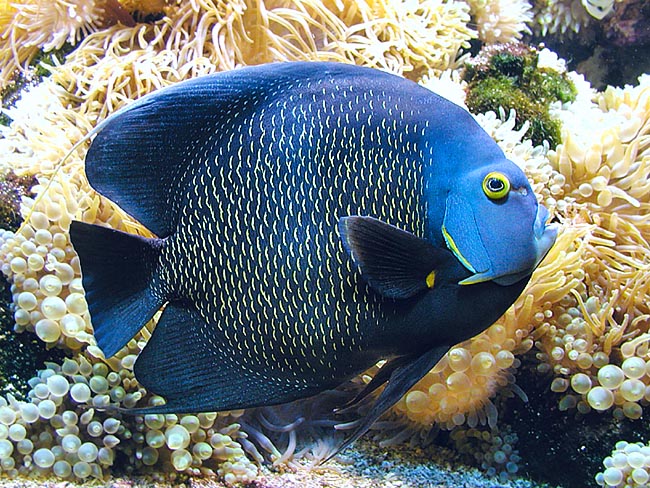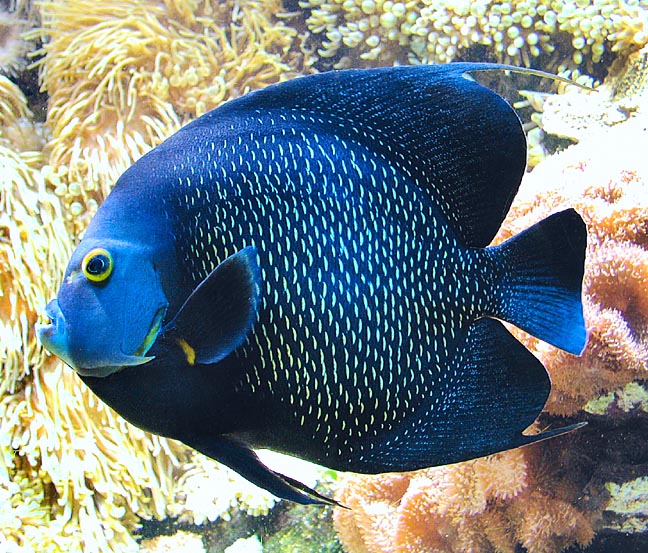Family : Pomacanthidae

Text © Giuseppe Mazza

English translation by Mario Beltramini

The splendid French angelfish (Pomacanthus paru) is discoidal and may exceed the 40 cm © Giuseppe Mazza
The French angelfish (Pomacanthus paru Bloch, 1787) belongs to the class of Actinopterygii, the ray-finned fishes, to the order of Perciformes and to the family of Pomacanthidae.
The etymology of the genus comes from the Greek “poma” = cover and “akantha” = spine, due to the presence of a showy spine protruding from the preopercular zone.
The name of the species “paru” does not come from the Greek or the Latin but from the local Brazilian name “paru-preto”, of Portuguese origin.
Zoogeography
It is present in the tropical waters of the Atlantic Ocean, mainly in the American ones.
Even if, as it’s suggested by one of its vulgar names, it’s at home in the Caribbean, it has, in fact, colonized Ascension Island, closer to Africa than to South America and the St. Paul’s Rocks Archipelago.
We find it in the southern USA, in Mexico, Belize, Nicaragua, Panama, Colombia, Venezuela, Guyana, Surinam and Brazil, not to forget countless islands, such as the Bahamas, Cuba, Haiti, Dominican Republic, Jamaica, Puerto Rico, Anguilla, St. Kitts and Nevis, Antigua and Barbuda, Guadeloupe, Dominica, Martinique, St. Lucia, St. Vincent, Barbados, Grenada, and Trinidad and Tobago.
Ecology-Habitat
It usually lives between the 5 and the 25 m of depth, among the corals, the madrepores and the rocks where t finds food and shelter, but also on the outer side of the reefs, in the middle of the currents, up to 100 m.

It eats algae, tunicates, sponges, crustaceans and cnidarians. Can live 10 years in aquarium © Giuseppe Mazza
Morpho-physiology
It can exceed the 40 cm.
The body, flat and discoidal, shows a big dorsal fin, rounded at the apex but a typical filament above, which counts 10 spiny rays and 29-31 soft. The anal fin, almost specular but smaller, shows 3 spines and 22-24 unarmed rays ending in a filament. The pectoral ones are rounded on the lower edge with 19-20 soft rays and the ventral, spineless, are long and pointed. The caudal fin is more or less rounded.
The livery is unmistakeable. Apart the pale blue head, with a yellow ring around the eye and a small stripe of the same colour at the base of the pectoral fins, the body is dark blue with scales bordered of yellow. Characteristic are also the already mentioned prolongations of the dorsal and of the anal fins which may even exceed the extremity of the caudal.
The juveniles, completely different, are black with 4 yellow vertical bands, more or less curved, and an almost triangular profile.
Ethology-Reproductive Biology
The French angelfish is omnivorous. It nourishes of seaweeds, tunicates and of sponges like Myrmekioderma styx, Desmacella meliorata, Anthosigmella varians, Ectyoplasia ferox, Pseudoceratina crassa, Plakortis angulospiculatus and the members of the genus Cliona; polyps of cnidarians of the genera Plexaura and Pseudoplexaura, not to forget of the crustaceans and other benthic animals. The juveniles, like those of the Holacanthus bermudensis often act as cleaning fishes, freeing, like the Labroides, various ichthyic species from their ectoparasites.
It is a protogynous hermaphrodite species: the females, in fact, may transform in males, once a certain size is reached. It lives alone or in pairs which defend vigorously their territory. The marriages, with the dispersion of the eggs and the fecundation, take place early in the morning in surface. The larvae are pelagic and the young install among the corals only starting from the length of 15 mm.
Present in almost all the public aquaria, thanks to its beauty, the easiness of alimentation and the fact that it can live even 10 years, the Pomacanthus paru is also sporadically consumed by the Caribbean fishermen, careless of the risk of ciguatera, a serious alimentary intoxication connected to the presence of venomous organism in their diet. In the wild, the populations can double n 1,4-4,4 years and the species has a moderate, but already worrying, vulnerability index of 39 on a scale of 100.
Synonyms
Chaetodon paru Bloch, 1787.
→ For general information about FISH please click here.
→ For general information about BONY FISH please click here
→ For general information about CARTILAGINOUS FISH please click here.
→ To appreciate the BIODIVERSITY of BONY FISH please click here.
→ To appreciate the BIODIVERSITY of CARTILAGINOUS FISH please click here.
